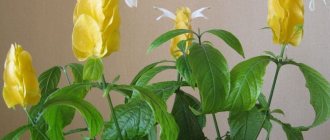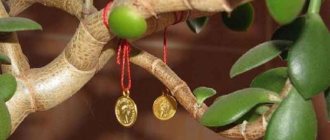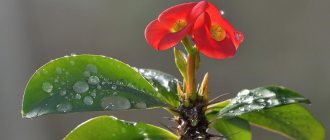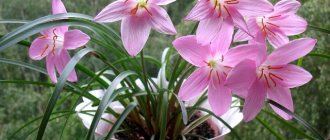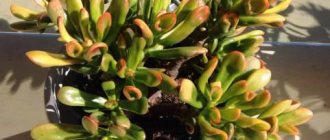Houseplant Chlorophytum - description
In general, chlorophytum is the name of more than one plant. This is the name of a whole genus of herbaceous perennials. And the genus is part of the family... This is where scientists begin to disagree: previously, for example, chlorophytum was classified as, surprisingly, the lily family. However, now they have reached a consensus and decided that this is still the asparagus family.
Chlorophytum is loved for its appearance, although not as bright and exotic as that of an orchid or rose, but pleasant and uplifting. They also love it for its beneficial properties: it is believed that chlorophytum absorbs harmful compounds that contain oxygen around it - this helps it nourish the microorganisms that live inside it and keep it healthy.
And with abundant watering, chlorophytum can even humidify the air. Therefore, it is often started by people with problems with the respiratory system or who want to freshen the air a little at home.
What does chlorophytum look like?
Like a low (up to half a meter in height) bush, practically devoid of a stem - long leaves come straight from the root. They are elongated, pointed in shape, do not stick out upward, on the contrary, they hang down, resembling either disheveled hair or a small green fountain. The root, on the other hand, is thick and hard, white in color, prone to moisture gain, since the plant comes from arid regions and must somehow survive during periods of drought.
The basis for the decorativeness of chlorophytum is, of course, its long (15-60 centimeters), narrow (three centimeters) leaves, so breeders have already developed many different species: without white stripes, with them, with yellow stripes, with different “styles” of green hair. Sometimes chlorophytum is even grown in an aquarium to decorate a room: behind glass, surrounded by a miniature landscape, it looks not just like a flower, but like a miniature jungle.
Blooms or not
With good care - yes, of course, it blooms, starting from the second year of life, just not very noticeably, not decoratively. It blooms from March to September, with small buds with thin white petals on long stems. The main reason for the lack of flowering is a pot that is too large, due to which the plant actively develops roots, but does not develop the above-ground part.
How fast it grows
Fast enough. In the first two to three years of its life, it requires an annual repotting because it grows out of an old pot. Then transplants are done less frequently.
Are Chlorophytum Poisonous or Not?
Absolutely non-toxic: no juice, no leaves, no fumes from chlorophytum, no flowers. It’s not even dangerous for pets if they suddenly decide to eat it. However, you still shouldn’t let them gnaw the plant - then it won’t be beautiful, and the gnawed leaves will turn yellow.
Homeland of the plant
South Africa.
Plant "Mother-in-law's tongue"
This is an indoor plant with long narrow leaves, it is not fussy about care, so growing it will not be difficult.
The flower needs to be provided with bright lighting so that it actively develops, but in the shade, the flower also feels good. In order to prevent root rotting, watering should not be abundant.
This flower is called “Laurentia”; it can be grown in bright or not very bright light, maintaining a temperature of 15 to 26 degrees. Between watering procedures, the soil should dry completely. The length of the bush can reach 1.2 meters.
How to care for Chlorophytum at home
Chlorophytum is an unpretentious plant, but still you should not buy it and leave it in the dark and alone, forgetting about care. Moreover, it is completely uncomplicated, and neglecting it leads to pathologies. Here you will learn the basic rules of care, the observance of which will help keep your flower healthy and happy.
What to do after purchase
Usually, flowers are quarantined after purchase so that mutual infection does not occur if you already have home flowers and they can infect a newcomer with something (or a newcomer can infect them). It is not necessary to do this here: chlorophytum tolerates being in the vicinity of other plants well.
Carefully inspect the chlorophytum for pests, and if everything is fine, replant it (store-bought soil is too poor in nutrients for the flower to stand in it for a long time) and place it in a pre-selected place. You can water it immediately - chlorophytum loves moisture - and spray or wipe with a damp cloth to remove outdoor dust from the leaves.
Lighting
Bright, but diffuse, in direct sunlight for several hours, chlorophytum will get sunburn. Variegated chlorophytum (also called striped, variant, most often with white stripes) requires more light to maintain the color of the hair.
Content temperature
It is absolutely unpretentious to temperature, the main thing is that there are no drafts. However, you should not overfreeze: at temperatures below ten degrees in winter, chlorophytum will die.
Humidity
It’s not whimsical, but if you want to please your green pet, it’s better to spray it, especially when it’s hot. This way it develops better, and you will thank it for releasing most of the moisture it receives back into the atmosphere.
Watering
Average. Chlorophytum is not a desert cactus, but you can’t call it a water-drinker either. How often to water depends on the season.
in winter
Watering is reduced and carried out only when the top layer has dried. Cool air temperatures and excess moisture, its stagnation in the pot leads to rotting of the roots.
In summer
More abundant, regular, so that the ground is always a little moist. Be sure to make drainage holes and remove excess moisture in a timely manner so that it does not stagnate.
Fertilizer and feeding
Fertilize only in summer and spring, when the active phase of growth and growth of children is underway. Fertilize twice a month with complex mineral fertilizer.
Features of caring for dracaena
Narrow-leaved plants include dracaena; some of its types are demanding to care for, while others are not at all capricious. Dracaena needs feeding, watering, maintaining a certain temperature, and lighting, like any other flower. The pot can be placed on the north side; the bush favorably tolerates dry air, but for active development, the room must be warm and free of drafts.
For each type of plant, certain lighting rules are followed. Dracaena with variegated leaves is placed in a bright place so as to avoid direct sunlight. A bush with green leaves tolerates shade well, but it must be taken into account that insufficient light leads to a cessation of growth and loss of a healthy appearance.
Young plants are transplanted in early spring, when the roots completely fill the entire container and the bush becomes crowded. When the plant has grown strongly, pruning is performed in order to rejuvenate and form a bush. To do this, cut off the top and place it in water or peat so that it takes root, thus creating another bush.
The soil composition must be nutritious; it can be made independently from leaf and turf soil, as well as sand. A ready-made mixture is available for sale, which is universal.
Bloom
Usually, chlorophytum holders do not ask the question “what to do to make it bloom,” because chlorophytum blooms rather inconspicuously, its flowers do not bring aesthetic joy, and seeds are usually not used for propagation. However, of course, chlorophytum blooms in small, white inflorescences with thin petals on a long thin stem.
How chlorophytum blooms: photo
When does it bloom at home?
From March to September.
How often
Once a year, with good care, if it is not taken care of, it may not bloom. The most common reason for lack of flowering is a pot that is too large, leading to fattening (excessive development of the root system to the detriment of flowering). The solution is to transplant it into a smaller pot.
Reproduction
Usually, plants are propagated by active plant lovers who want a collection, but with chlorophytum the situation is a little different. With good care (and you probably carefully observe all the features of care), it actively produces children, that is, daughter bushes. It looks very nice, but the babies that are not removed deplete the mother plant. Therefore, you will have to learn how to at least remove them, and decide for yourself what to do with them next.
So, in what ways can you plant chlorophytum, and how does it reproduce? The most common and simplest methods: plant a shoot, plant it in a pot from a socket (you can even from a socket without a root), root a baby (they also say “plant a baby”). Seeds are rarely used, usually by professional breeders when many plants need to be planted at once. Below you will read about all the methods that are available to the simple amateur.
Rosettes
Essentially, this is cuttings. If you have already propagated some other plant by cuttings, then you can handle rosettes: a rosette is a bunch of chlorophytum leaves with its own root.
What should be done:
- Prepare the soil (the same as for an adult plant, you can buy universal soil), buy a small pot (diameter 8-10 centimeters) for the future sprout. Also, do not forget the drainage layer so that water does not stagnate in the pot when watering heavily.
- Carefully, with a sharp knife, so that you don’t have to break it off and saw it off like a surgical scalpel, separate the rosette - a bunch of healthy, strong leaves with a spine. Sprinkle the cut with crushed activated carbon to disinfect the wound. The cut should be made obliquely to make it easier for the mother plant to grow new leaves.
- Root, water and place in the shade for two weeks. In this case, you need to water frequently so that the soil always remains moist.
If there are no roots on the rosette, you can first root it in water. Place it in settled water (don’t forget to change it, top it up: the rosette will “drink” it, the amount of moisture will decrease), possibly with the addition of a growth stimulator, and wait a week until the rosette grows roots, and then replant it in the ground as described above.
Children
Babies are small bushes with their own aerial roots. They appear in the plant after a year and a half of life. Options for reproduction by children are as follows:
- Dig it in, and when it takes root, cut it off.
- Root in the ground. Cut off the baby (just like the rosette, as described above) and plant it in a separate pot. When it takes root, cut off the tendril with which it was attached to the mother plant.
- Root in water: cut, place in water, cover with plastic or glass (do not forget to ventilate every day for ten minutes), wait until the roots grow at least two centimeters, and then transplant into a pot.
Dividing the bush
This method is used for mature plants (over three years old) that have already developed a strong, large root system. The bush is divided during replanting in order to change the pot to a larger one.
It is best to do this in the spring or at the end of February, that is, before the start of the active growth phase, when nature itself will provide the young bush with suitable conditions, and it will be easier for the mother plant to cope with stress. By the way, dividing the bush is also useful for the mother plant: it rejuvenates it.
What you need to do: after removing the plant from the pot, clear the roots from the soil and use a knife to separate one or more bushes (depending on your desire and the volume of the root system). The bushes should be full-sized: with roots and leaves, like a miniature version of an adult chlorophytum. The separation rules are the same as with sockets: use a sharp knife, diagonally, then sprinkle with ground activated carbon for disinfection.
Plant young bushes in soil with increased nutritional value (with the addition of vermicompost, for example) and water more often. They will take root within a month, and then you can care for them like adult plants.
Adenium types and varieties
Adenium Crispum A succulent with narrow leaves, a thick massive trunk and elongated yellow or orange flowers. In indoor conditions it blooms in summer for 1-2 weeks, after which it drops its flowers. The root of the plant is shaped like a turnip, which, rising above the ground, looks very impressive.
Adenium Crispum
Adenium obesum An unpretentious variety with abundant flowering and a powerful trunk. The stem is very thick at the base, and branches and becomes thinner towards the top. The leaves are long, dense with a gray or silver tint on a lush green background. Flowers appear in summer and can be white or bright red.
Adenium obesum
Mini-Adeniums Breeders have managed to develop several types of mini-adeniums, which are formed in the form of bonsai in indoor floriculture. These dwarf trees grow very slowly, and the crown is able to form independently, so pruning is usually not necessary. Only adult plants that are at least 3 years old bloom.
Mini Adeniums (Mini Size)
Chlorophytum transplant
Transplanting at home sounds daunting, but in fact there is nothing complicated here, you just need to prepare everything you need in advance and act carefully and carefully.
The sequence of actions for transplantation is as follows:
- Prepare the soil and a new pot in advance (you will read a little below what they should be). Fill the pot halfway with soil.
- Gently loosen the soil in the old pot to make it easier to pull the plant out without damaging it.
- Pull it out carefully. Clean the roots from the soil; you can rinse them with water, but this is not necessary. If the pot has become small for chlorophytum, then its roots will be slightly curved, to fit the shape of the pot. If so, very carefully pull them down to straighten them.
- When replanting, it is convenient to inspect the roots and lower parts of the plant: often this is where signs of various diseases lurk (for example, aphids on the lower parts of leaves or root rot). Take advantage of this opportunity.
- If everything is in order, you can replant. Place the flower in the pot and fill in the remaining soil.
- Water it.
- If you notice rot or pests, go to the “Diseases” section and see what to do about them.
That's all, no difficulties, you did it.
When to replant
The end of February - the beginning of March, so that the chlorophytum meets the growing season in the new house and does not waste the energy it will need for active growth on coping with the stress of replanting.
How often
Young bushes grow quickly, so they are replanted annually, adults slow down their growth rate, so they are replanted every two to three years.
The main sign that it is time to replant is the roots. If they begin to protrude above the ground, it means that they are cramped in the pot, they have nowhere else to stretch and grow, and they begin to “hunch over” and grow upward. This means it’s time to change the chlorophytum’s house.
Chlorophytum is also replanted if the soil is depleted (symptoms and how to understand that this has happened, you will find in the section on diseases) or in order to control pests or correct care errors.
Priming
The easiest way is to buy soft, loose soil of neutral acidity in the store. But you can do it yourself: one part river sand, one part humus, two parts each of turf and leaf soil. Drainage is also necessary to prevent water from stagnating. Drainage is made either from expanded clay, or from pebbles or crushed bricks.
What kind of pot is needed for chlorophytum
Chlorophytum has a rapidly growing root system, so you need a wide and large pot, with holes to drain excess water. When transplanting, each new pot is three to four centimeters wider than the previous one.
Chlorophytum diseases and their treatment
Here we talk about what causes chlorophytum.
Diseases
It must be said that this is a plant, so to speak, with high and strong immunity. Most pathologies in its development (for example, it does not produce children, turns pale, does not bloom, does not grow) are not caused by some kind of disease from the outside, but simply by errors in care. Still, despite the unpretentiousness of this beautiful shrub, it requires care. Here are the symptoms that long-term neglect of it can lead to:
- The leaves are turning yellow.
| Possible reasons: | |
| The plant is old | Chlorophytum is one of the few plants that signals age like a person: by changing the color of the hair. This is a natural process, you don’t need to do anything about it, just remove the wilted leaves so that they don’t hang on the plant like a vestige. |
| Problems with hydration | Insufficient watering (chlorophytum releases into space most of the moisture it consumes, so it needs good watering) - restore regularity of watering. Excess moisture (in this case, the soil stores too much moisture, therefore, the roots rot) - transplant the chlorophytum into a new pot, where the soil will not be oversaturated with moisture, and temporarily reduce watering. |
| Something mechanically damaged the leaves, for example, they were torn off by a child or eaten by a cat | It's not dangerous, just remove the yellowed leaves. |
| Lack of nutrients in the soil, lack of fertilizing | Feed, the soil may be depleted, in this case it is necessary to replant the plant. |
| Potty too tight | The size should not be too large or too small: a pot that is too large leads to fattening, when the root system actively develops and the above-ground part is left unattended, and a pot that is too small leads to a lack of nutrients. Solution: transplant. |
- The leaves are turning pale.
The most common reason is lack of lighting; chlorophytum prefers abundant light.
What to do: usually simply moving the pot to a more illuminated place is enough, but if the blanching of the crown is severe, then you can also feed the plant. In winter, artificial lighting will not be superfluous.
- The leaves are darkening.
Cause: root rot. It occurs due to an excess of moisture, especially in winter, when it is cold; the combination of cold and waterlogging is harmful to any living organism - that is why, for example, people get sick in the fall.
What to do: sharply reduce watering, move the pot to a warmer place, stop feeding. It is advisable to trim off the darkened leaves - this is a rudiment for the plant body.
- The tips of the leaves have dried out.
Probable reasons: too infrequent watering, long breaks between them; depleted soil or insufficient fertilizing; watering with tap water.
What to do: remove damaged leaves, then replant in more nutritious soil (you can use ready-made soil to be sure that all the necessary nutrients are collected there), adjust watering.
The flower may also have problems due to pests. Pests are common in chlorophytum, and they often occur in other plants. The reasons for the appearance of pests are most often a sad coincidence (they flew from other plants, you carried them on your shoes from the street). However, most pests love dry and warm climates, so if you have one in your apartment, they are more likely to infest.
Pests of chlorophytum
- Shield.
Symptoms: sticky spots on leaves. The scale produces such a secretion, and because of it the plant becomes more easily infected with fungi.
What to do: remove all insects using a cloth or cotton pad soaked in soapy water and then treat with insecticides. The problem with scale insects is that they have plates on their backs that protect them from “chemical attack” by drugs. Therefore, it will probably be necessary to treat the plant several times (with a break of a week) with different insecticides so that scale insects do not have time to adapt to them.
- Aphid.
Symptoms: Aphids are usually visible visually: they are small, bright green bugs that usually live on the back sides of plants. The aphid itself is harmless, but it draws juices from the plant, which, firstly, harms its appearance, and secondly, reduces resistance to other diseases.
What to do: wash off all insects under running water, treat with a preparation to kill aphids. Folk remedies also help, for example, tincture of orange peels and laundry soap, but this is an unreliable remedy.
- Spider mite.
Symptoms: a characteristic thin coating on the leaves, similar to a cobweb, their curvature and yellowing.
What to do: Use a damp cotton pad to carefully remove all plaque and all insects from the plant; you can rinse it in the shower. It is advisable to replant it, because spider mites lay eggs in the soil, and treat it with an anti-mite preparation. Spider mites often appear in winter, when the air is dry and hot from heating devices, so it makes sense to introduce spraying to keep the leaves of chlorophytum moist.
Yucca care technology
Yucca also has long, narrow leaves and looks a bit like dracaena. This plant is quite tolerant of dry air, so it can be grown in apartment conditions. In its usual conditions, yucca can grow up to 14 meters, and indoors up to two meters.
The plant is not capricious in caring for it; dry leaves are periodically cut off, watered, and the temperature in winter is kept at least 18 degrees, and in summer the indicator should be moderate. Planting can be done in a special mixture of peat, sand, humus, deciduous and turf soil or purchased universal soil. The transplant is performed in the spring, which is the most favorable. If the container is large, then replace the top layer of soil.
Even in winter, the room is ventilated, but the plant is removed from strong temperature changes and drafts. The tree tolerates dry air favorably, so spraying is not necessary; sometimes you can wipe the leaves with a damp sponge to remove dust and give the bush a fresh look.
Popular varieties of Chlorophytum with photos and names
Although chlorophytum cannot boast of bright flowers, it pleases with pleasant green leaves. Here are a few common varieties so you can choose the one that suits you best.
Crested
The most common type. It is notable for its “crestedness” - the hair is thick, the leaves curl slightly, it looks lush and charmingly disheveled. The color of the leaves is yellow-green, with a yellow stripe in the center.
Orange (Orange) aka Winged, Orchidastrum, Orchidstar
An unusual species, in which you don’t even immediately recognize a “green fountain”: instead of thin and long leaves, they are oval, dark green, large, with bright orange bases.
Bonnie (Curly or Curly)
Very similar to the “tufted” variety, but more creeping, reminiscent of ivy or bindweed, with thinner leaves, due to which it appears more curly. The color of the leaves is the same as that of the “crested” variety, but the green part is a little lighter.
Cape
A more austere-looking variety: the leaves are almost one-color (the thin strip along the edges is almost invisible), rich dark green, malachite color. Decorate a man's office in strict brownish-green tones.
Ocean (Ocean)
The classic appearance for chlorophytum: a small plant, convenient to place on a table or to decorate a work room, the leaves are quite wide, with a narrow yellow stripe along the edges.
Laxum (Chlorophytum Laxum)
It is very similar to the previous view, only the style of the hair has changed (the leaves rise upward more, and do not crawl in breadth straight from the ground), and their green part is brighter.
Comosum (Chlorophytum Comosum)
A pleasant variety with a sunny color due to the wide yellow stripe in the middle of the leaf. Looks good both in a flower pot and just on the table.
Atlantic
Not a very bushy variety with thin, long leaves (yellow stripe in the center, green border around the edges), but the leaves curl in interesting spirals.
Lemon
Miniature, minimalistic variety: the leaves are single-colored, do not spread around the pot, like other varieties, but stick up in green miniature peaks.
Variegata
An even more minimalistic variety with thin leaves sticking out in different directions, like a bunch. The leaves are yellow with a thin border around the edges, making the plant appear yellow rather than green from a distance.
Coconut palm
Coconut palm (lat. Cōcos nucifēra) is a plant of the Palm family (Arecaceae); the only species of the genus Cocos. The scientific name of the genus comes from the Portuguese word coco ("monkey") and is given because of the spots on the nut that make it look like a monkey's face.
The species name nucífera comes from the Latin words nux (“nut”) and ferre (“to carry”). The origin of the coconut palm is unknown; it is believed to be native to Southeast Asia (Malaysia). Now it is widespread in the tropics of both hemispheres, both in cultivated and wild forms.
In the Philippines, the Malay Archipelago, the Malay Peninsula, India and Sri Lanka, it has been bred since prehistoric times. Coconut is a plant of sea coasts that prefers sandy soils, so the first place in production volumes by a large margin is occupied by a multi-island state with a vast coastal area - Indonesia (see below).
The expansion of its range occurred with the help of humans and naturally: coconuts are waterproof and float freely on the water, they are carried far by ocean currents, while maintaining vitality. Tall (up to 27-30 m) slender palm tree.
The trunk is 15-45 cm in diameter, smooth, ringed with fallen leaves, slightly inclined and widened at the base. There are no lateral branches, but supporting roots often develop below. The leaves are pinnately dissected, dense, 3-6 m long. There are from 20 to 35 leaves in the crown.
Is it possible to keep chlorophytum at home: the benefits and harms of a kitchen flower
From a biological point of view, chlorophytum is a plant whose beneficial properties are exceptional. The plant absorbs all harmful substances around itself (experiments have shown that it absorbs up to 80-90% of harmful substances in the air), and in return releases purified oxygen; it also humidifies the air around.
Clean, fresh, humidified air has a positive effect on well-being, clarity of thoughts, and the health of the respiratory and cardiovascular systems, especially if you live in the city. Chlorophytum is known mainly because of this combination: beneficial properties plus amazing ease of care.
From the point of view of “subtle matters”, signs and superstitions (of course, it’s up to you to decide whether to believe them), everything is basically also very positive. It is believed that chlorophytum:
- A plant saturated with “yang” energy, that is, creative, active, masculine energy. Therefore, it should be placed where there is a lot of such energy - for example, in the office.
- It is believed that chlorophytum clears thoughts and helps make the right decisions. From the point of view of biology and physiology, this is indeed true: when a person breathes clean air, he thinks much better.
- For the same reason, it is believed that chlorophytum helps to study better and remember information better.
- A half-joking sign: they say that if chlorophytum grows very luxuriantly, it means that the air in the room is very dirty. Chlorophytum is an amazing plant that benefits from harmful compounds; it processes them. But they are harmful to humans, so if it grows too luxuriantly, it seems like it’s time for you to move from this area near the waste recycling plant.
- Attracts good luck.
- For an unmarried housewife, chlorophytum attracts a loved one, and for a married woman it indicates how things are in the relationship with her spouse: they say that if chlorophytum fades, it means that the spouse is unfaithful.
- Blooming chlorophytum - to success.
As for harm, chlorophytum is absolutely harmless even for pets, although, of course, it is better not to let them eat green leaves. It's a pity.
Interesting facts about chlorophytum
- Chlorophytum is also called "natural (or green) conditioner", and also green fountain, bridal veil or more gloomily - spider, because of the long thin stems that look like spider legs. However, there are varieties of chlorophytum with spiny leaves or purple chlorophytum - they really can cause darker associations. And sometimes, surprisingly, it is called green lily.
- Chlorophytum is translated from Latin as “green plant”.
- Another name for the plant is more functional: “kitchen flower.” Because of its beneficial qualities, chlorophytum is often placed in the kitchen so that it absorbs harmful substances that are released there during cooking.
- It calmly tolerates proximity to other plants, and even creates a more favorable climate for them due to the fact that it actively releases oxygen into the air, moisturizes and purifies the air.
- Many plants do not tolerate harmful substances in the air around them, such as tobacco smoke. Chlorophytum is a happy exception here: it absorbs such substances and feels great about it.
- Chlorophytum was discovered at the end of the eighteenth century, and by the end of the nineteenth it became popular as a green pet. It is especially popular in Holland.


